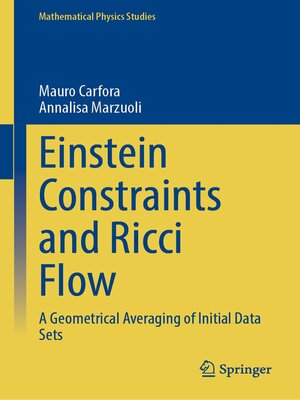Einstein Constraints and Ricci Flow
ebook ∣ A Geometrical Averaging of Initial Data Sets · Mathematical Physics Studies
By Mauro Carfora

Sign up to save your library
With an OverDrive account, you can save your favorite libraries for at-a-glance information about availability. Find out more about OverDrive accounts.
Find this title in Libby, the library reading app by OverDrive.



Search for a digital library with this title
Title found at these libraries:
| Library Name | Distance |
|---|---|
| Loading... |
This book contains a self-consistent treatment of a geometric averaging technique, induced by the Ricci flow, that allows comparing a given (generalized) Einstein initial data set with another distinct Einstein initial data set, both supported on a given closed n-dimensional manifold.
This is a case study where two vibrant areas of research in geometric analysis, Ricci flow and Einstein constraints theory, interact in a quite remarkable way. The interaction is of great relevance for applications in relativistic cosmology, allowing a mathematically rigorous approach to the initial data set averaging problem, at least when data sets are given on a closed space-like hypersurface.
The book does not assume an a priori knowledge of Ricci flow theory, and considerable space is left for introducing the necessary techniques. These introductory parts gently evolve to a detailed discussion of the more advanced results concerning a Fourier-mode expansion and a sophisticated heat kernel representation of the Ricci flow, both of which are of independent interest in Ricci flow theory.
This work is intended for advanced students in mathematical physics and researchers alike.
This is a case study where two vibrant areas of research in geometric analysis, Ricci flow and Einstein constraints theory, interact in a quite remarkable way. The interaction is of great relevance for applications in relativistic cosmology, allowing a mathematically rigorous approach to the initial data set averaging problem, at least when data sets are given on a closed space-like hypersurface.
The book does not assume an a priori knowledge of Ricci flow theory, and considerable space is left for introducing the necessary techniques. These introductory parts gently evolve to a detailed discussion of the more advanced results concerning a Fourier-mode expansion and a sophisticated heat kernel representation of the Ricci flow, both of which are of independent interest in Ricci flow theory.
This work is intended for advanced students in mathematical physics and researchers alike.







